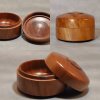I have been told that I work too much with Koa... Perhaps they are right, but, if you had the chance of always working with gold, wouldn't you? LOL
I guess thats why I'm not an expert about other woods. As you know, I just started Hand Thread chasing.
My instinct was right with the first wood I had a hunch was going to work: Lychee. Perfect little ribbons come out when you chase threads...
Then, yesterday, I tried Ohia. Ohia is a very hard wood, very heavy. My question is: can a wood be hard and heavy but not dense enough for chasing threads? I assume hard woods are dense, but I just learned today and yesterday, hard and heavy doesn't equal dense, or dense enough. You also hear about "Tight grain" Is that another name for dense?
Today I tried with Koa'ia. A cousin of the Koa. Much better than Ohia, but not as good as Lychee...
On the other discussion, someone mentioned I should try Milo. Milo is considered a hard wood, but compared to Koa, or Koa'ia, is soft. I can leave Milo glassy, makes me look really good! I'm guessing its dense, but not too hard or heavy...
I f you never tried Thread chasing, do not try it. It is highly addicting, your life will be on hold for a while, making the wife upset. Aloha from Maui
I guess thats why I'm not an expert about other woods. As you know, I just started Hand Thread chasing.
My instinct was right with the first wood I had a hunch was going to work: Lychee. Perfect little ribbons come out when you chase threads...
Then, yesterday, I tried Ohia. Ohia is a very hard wood, very heavy. My question is: can a wood be hard and heavy but not dense enough for chasing threads? I assume hard woods are dense, but I just learned today and yesterday, hard and heavy doesn't equal dense, or dense enough. You also hear about "Tight grain" Is that another name for dense?
Today I tried with Koa'ia. A cousin of the Koa. Much better than Ohia, but not as good as Lychee...
On the other discussion, someone mentioned I should try Milo. Milo is considered a hard wood, but compared to Koa, or Koa'ia, is soft. I can leave Milo glassy, makes me look really good! I'm guessing its dense, but not too hard or heavy...
I f you never tried Thread chasing, do not try it. It is highly addicting, your life will be on hold for a while, making the wife upset. Aloha from Maui




